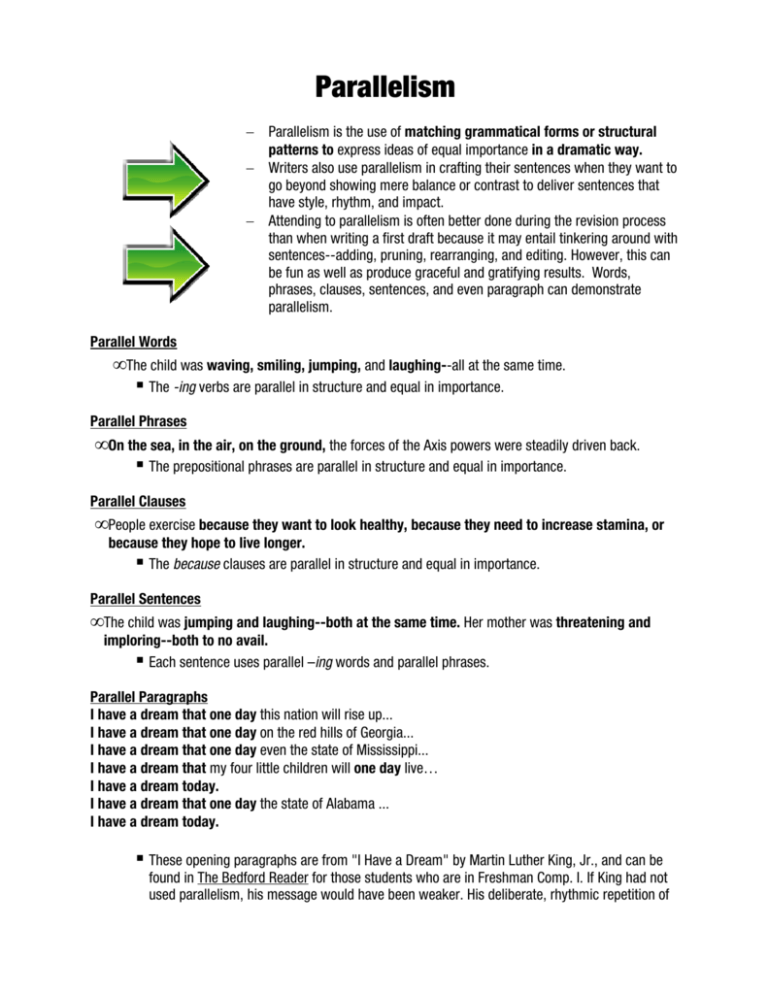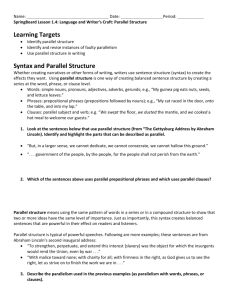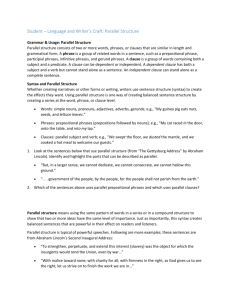Parallelism - Valencia College
advertisement

Parallelism − Parallelism is the use of matching grammatical forms or structural patterns to express ideas of equal importance in a dramatic way. − Writers also use parallelism in crafting their sentences when they want to go beyond showing mere balance or contrast to deliver sentences that have style, rhythm, and impact. − Attending to parallelism is often better done during the revision process than when writing a first draft because it may entail tinkering around with sentences--adding, pruning, rearranging, and editing. However, this can be fun as well as produce graceful and gratifying results. Words, phrases, clauses, sentences, and even paragraph can demonstrate parallelism. Parallel Words • The child was waving, smiling, jumping, and laughing--all at the same time. The -ing verbs are parallel in structure and equal in importance. Parallel Phrases • On the sea, in the air, on the ground, the forces of the Axis powers were steadily driven back. The prepositional phrases are parallel in structure and equal in importance. Parallel Clauses • People exercise because they want to look healthy, because they need to increase stamina, or because they hope to live longer. The because clauses are parallel in structure and equal in importance. Parallel Sentences • The child was jumping and laughing--both at the same time. Her mother was threatening and imploring--both to no avail. Each sentence uses parallel –ing words and parallel phrases. Parallel Paragraphs I have a dream that one day this nation will rise up... I have a dream that one day on the red hills of Georgia... I have a dream that one day even the state of Mississippi... I have a dream that my four little children will one day live… I have a dream today. I have a dream that one day the state of Alabama ... I have a dream today. These opening paragraphs are from "I Have a Dream" by Martin Luther King, Jr., and can be found in The Bedford Reader for those students who are in Freshman Comp. I. If King had not used parallelism, his message would have been weaker. His deliberate, rhythmic repetition of parallel word forms and structural patterns creates an echo effect that uses balance and poetry to help deliver his meaning. According to critic Mia Klein Anderson, "[King] knew that his effectiveness in reaching his wider audience would come both from what he said and from how he said it. The words can reach the mind, but the music and imagination can reach the heart and soul." Parallel Forms with Coordinating Conjunctions • To make elements joined by for, and, nor, but, or, yet, and so (FANBOYS) parallel, put them in the same grammatical form. Love and marriage go together. Being in love and being married go together. Parallel Forms with Correlative Conjunctions • Pairs of words such as both...and, not...so much as, not...but, not only...but (also), either... or, neither...nor, whether... or, and just as...so need to be in the same grammatical form. The verb may be used once if it applies to both parts. It is not that the cream is warm so much as that it has curdled that makes me hesitate to pour it in my coffee. Differing expectations for marriage can lead not only to disappointment but also to depression. Parallel Forms with Than and As • When using than and as for comparisons, be sure that elements are parallel in grammatical form and that these comparisons are complete. Having a solid marriage can be more satisfying than acquiring wealth. A solid marriage can be more satisfying than wealth. A solid marriage can be as satisfying as, if not more satisfying than, wealth. Two variations to the parallel sentence pattern exist, which students might want to experiment with during the revision process: Antithesis • This device juxtaposes contrasting ideas That's one small step for a man, one giant leap for mankind. Chiasmus • Sometimes called 'the criss-cross," the elements of a first phrase, clause, or sentence are inverted in the second phrase, clause, or sentence. Humankind must put an end to war, or war will put an end to humankind. Let us never negotiate out of fear. But never let us fear to negotiate.







